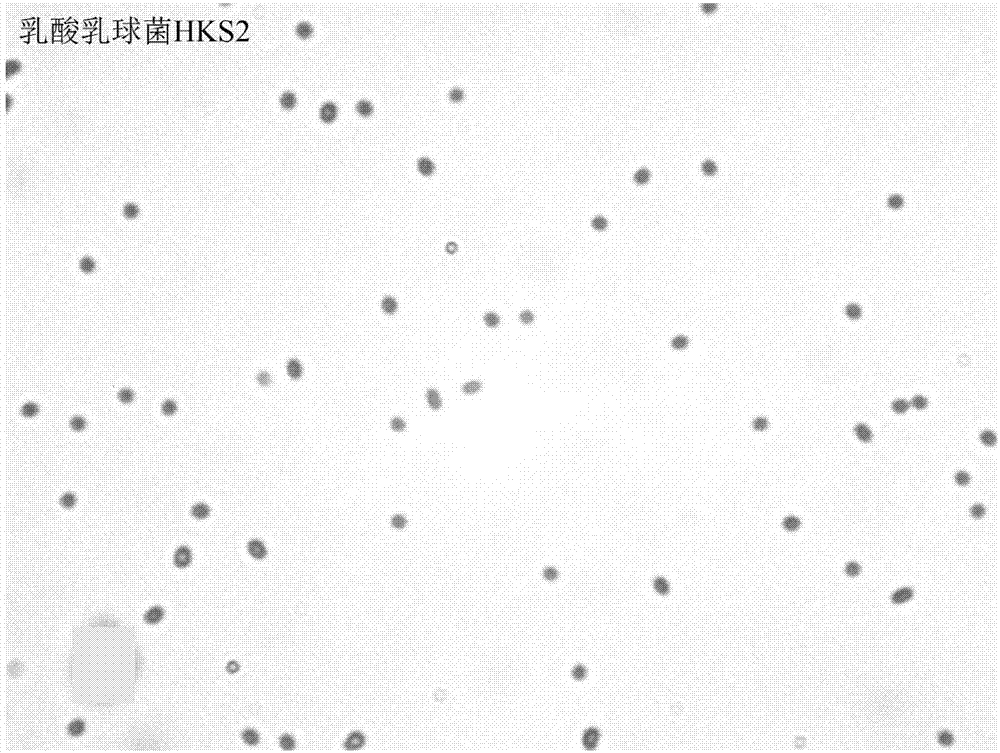Lactococus lactis HKS2 having lactic acid activity and separating and screening method and application thereof
A Lactococcus lactis, separation and screening technology, applied in the field of strains, can solve the problems of no Lactococcus lactis Hainan Island geographical population patent, unstable purification effect, and few Lactococcus lactis, etc., to improve immunity and inhibit the effect of Significant, strong acid-producing effect
- Summary
- Abstract
- Description
- Claims
- Application Information
AI Technical Summary
Problems solved by technology
Method used
Image
Examples
Embodiment 1
[0053] Example 1 Isolation and screening of Lactococcus lactis HKS2.
[0054] The separation and screening method of the above-mentioned Lactococcus lactis HKS2 of the present invention mainly comprises the following steps:
[0055] (1) Sample collection
[0056] Seawater and live shrimp intestinal contents were collected from the waters of Wenchang shrimp farm in Hainan and tropical live Litopenaeus vannamei respectively, and a small amount of the collected seawater samples were taken for later use; Shred shrimp intestines, shake and mix into shrimp intestine mixture; take a small amount of mixture for later use, and the whole operation process is carried out on the ultra-clean bench;
[0057] (2) Expanded culture of sample strains
[0058] The seawater sample and shrimp intestinal mixture described in step (1) were respectively inoculated into the MRS liquid medium, and cultured in a shaker at 30°C and 180r / min for 24h;
[0059] (3) Preliminary isolation of strains
[00...
Embodiment 2
[0065] Example 2 Molecular identification of Lactococcus lactis HKS2.
[0066] In order to identify the strains, the cell morphology and some physiological and biochemical reactions of the tested strains were first observed by scanning electron microscope, as shown in the scanning electron microscope figure 2 As shown, it can be preliminarily judged that the strain is Lactococcus lactis.
[0067] Use the bacterial universal primers to carry out PCR identification on the screened bacterial strains: extract the template DNA according to the operating instructions of the bacterial DNA extraction kit. Using the upstream primer 5'-AGAGTTTGATCCTGGCTCA-3' of the 16S rRNA conservative sequence, see SEQ ID No.2 and the downstream primer 5'-GGTTACCTTGTTACGACTT-3, see SEQ ID No.3, perform PCR amplification on the 16srRNA gene fragment of Lactococcus lactis HKS2 Amplified, cloned and sequenced. After sequencing, 1409bp fragments were obtained respectively. The accession number in GenBan...
Embodiment 3
[0068] Example 3 Acid-producing ability test of Lactococcus lactis HKS2.
[0069] Acid-producing ability test: first use the inoculation loop to pick out the target strain of primary screening, inoculate the strain in the MRS liquid medium aseptically, and then shake and culture it in a 30°C incubator at 180rpm for 24 hours, and set aside; prepare the MRS solid medium ( Add 1% light CaCO 3 ), pour 20mL culture medium into each petri dish, and use diluted 10 8 100 μL of cfu / mL bacterial solution was spread on the solid medium in the petri dish, and cultured in a 30°C incubator for 48 hours, and the diameter of the calcium dissolution circle was measured with a vernier caliper. Each sample was set for 3 repetitions, and the average value was taken. Finally, it was determined that the diameter of the calcium-dissolving circle of Lactococcus lactis HKS2 reached 5.00-7.00mm, such as figure 1 shown by figure 1 The diameter of the calcium-dissolving circle shows that Lactococcus l...
PUM
| Property | Measurement | Unit |
|---|---|---|
| Diameter | aaaaa | aaaaa |
| Diameter | aaaaa | aaaaa |
Abstract
Description
Claims
Application Information
 Login to View More
Login to View More - R&D
- Intellectual Property
- Life Sciences
- Materials
- Tech Scout
- Unparalleled Data Quality
- Higher Quality Content
- 60% Fewer Hallucinations
Browse by: Latest US Patents, China's latest patents, Technical Efficacy Thesaurus, Application Domain, Technology Topic, Popular Technical Reports.
© 2025 PatSnap. All rights reserved.Legal|Privacy policy|Modern Slavery Act Transparency Statement|Sitemap|About US| Contact US: help@patsnap.com



